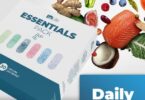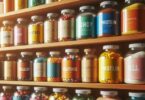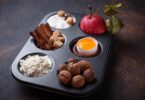Eating a balanced and varied diet is one of the best ways to support your health and well-being. However, some foods may be more beneficial or harmful than others, depending on your individual needs and goals. In this article, we will explore some nutrition food lists that can help you choose the right foods for different purposes, such as increasing hemoglobin, reducing belly fat, or avoiding gallstones. We will also provide some tips and examples of how to incorporate these foods into your daily meals.
High Sodium Foods
Sodium is an essential mineral that helps regulate fluid balance, blood pressure, and nerve and muscle function. However, consuming too much sodium can increase your risk of high blood pressure, heart disease, stroke, kidney disease, and osteoporosis. The American Heart Association recommends limiting your sodium intake to no more than 2,300 milligrams (mg) per day, and ideally to 1,500 mg per day for most adults.
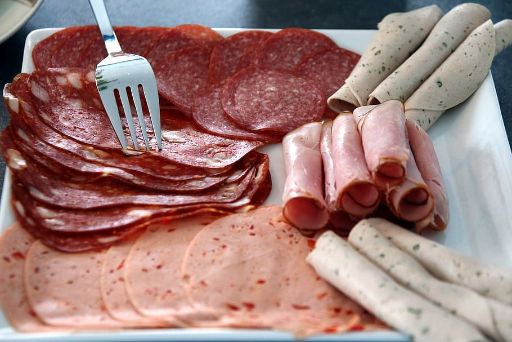
Some of the high sodium foods include:
• Processed meats, such as bacon, ham, salami, hot dogs, sausages, and deli meats
• Canned or packaged soups, broths, sauces, gravies, dressings, and condiments
• Pickled or fermented foods, such as pickles, olives, sauerkraut, kimchi, and soy sauce
• Salted snacks, such as chips, pretzels, crackers, popcorn, and nuts
• Cheese and dairy products, especially processed cheese and cheese spreads
• Breads and baked goods, especially those made with baking soda or baking powder
• Fast foods and restaurant meals, especially those that are fried or have added sauces or toppings
To reduce your sodium intake, you can:
• Read nutrition labels and choose foods that are low in sodium or have no added salt
• Cook your own meals using fresh or frozen ingredients and herbs and spices instead of salt
• Rinse canned foods, such as beans, vegetables, and tuna, to remove some of the sodium
• Ask for sauces and dressings on the side when eating out and use them sparingly
• Use a salt substitute or a potassium-based salt alternative if advised by your doctor
Carnivore Diet Food List
The carnivore diet is a type of low-carb diet that involves eating only animal products and avoiding all plant-based foods. It is based on the premise that humans are designed to eat meat and that plants contain anti-nutrients that can harm health. However, there is no scientific evidence to support the claims or benefits of this diet. In fact, it may pose several health risks due to its lack of fiber, vitamins, minerals, antioxidants, and phytochemicals.

The carnivore diet food list includes:
• Meat from any animal source, such as beef, pork, lamb, chicken, turkey, fish, and organ meats
• Eggs from any bird source
• Dairy products from any animal source, such as milk, cheese, butter, and yogurt
• Animal fats from any animal source, such as lard, tallow, ghee, and bone marrow
The carnivore diet food list excludes:
• Fruits and vegetables of any kind
• Grains of any kind
• Legumes of any kind
• Nuts and seeds of any kind
• Oils from plant sources
• Herbs and spices from plant sources
• Beverages other than water or animal-based drinks
To follow the carnivore diet, you can:
• Eat as much meat, eggs, dairy, and animal fats as you want until you are full
• Drink only water or animal-based drinks, such as bone broth or milk
• Avoid any food that comes from plants or contains plant ingredients
Dr Sebi Food List
Dr Sebi was a self-proclaimed herbalist who promoted a plant-based diet that he claimed could cure various diseases. He based his diet on the African Bio-Mineral Balance theory, which states that disease is caused by mucus buildup in the body due to an acidic environment. He claimed that by eating alkaline foods that are natural, electric, and non-hybrid, you can restore your body’s natural alkaline state and detoxify your diseased body. However, there is no scientific evidence to support his claims or his diet. In fact, his diet may be deficient in some nutrients and may not be suitable for everyone.

Dr Sebi food list includes:
• Vegetables, such as amaranth greens, avocado, bell peppers, chayote, cucumber, dandelion greens, garbanzo beans, izote, kale, lettuce (except iceberg), mushrooms (except shiitake), nopales, okra, olives, onions, poke salad greens (removed), squash (except butternut), tomato (cherry and plum only), turnip greens, zucchini, watercress, purslane, and wild arugula
• Fruits, such as apples, bananas (smallest or burro), berries (except cranberries), cantaloupe, cherries, currants, dates, figs, grapes, limes (key limes preferred), mangoes, melons (seeded), oranges (Seville or sour), papayas, peaches, pears, plums, prickly pear (cactus fruit), prunes, raisins (seeded), soft jelly coconuts (coconut jelly), soursops, sugar apples (removed), and tamarind
• Grains, such as amaranth, fonio, kamut, quinoa, rye, spelt, tef, and wild rice
• Oils, such as olive oil (do not cook), coconut oil (do not cook), grapeseed oil, sesame oil, hempseed oil, and avocado oil
• Nuts and seeds, such as hemp seeds, raw sesame seeds, raw sesame tahini, walnuts, and Brazil nuts
• Herbal teas, such as alvaca (removed), anise (removed), burdock, chamomile, elderberry, fennel, ginger, red raspberry, cuachalalate, flor de manita, gordo lobo, muicle, and tila
Dr Sebi food list excludes:
• Meat and animal products of any kind
• Dairy products of any kind
• Eggs of any kind
• Alcohol of any kind
• Caffeine of any kind
• Sugar of any kind
• Salt of any kind (except pure sea salt or powdered granulated seaweed)
• Vinegar of any kind
• Baking soda or baking powder of any kind
• Yeast of any kind
• Soy products of any kind
• Corn products of any kind
• Wheat products of any kind
• Rice products of any kind (except wild rice)
• Potato products of any kind (except sweet potatoes)
• Carrot products of any kind
• Peanut products of any kind
• Cashew products of any kind
• Sunflower products of any kind
• Canola products of any kind
• Hybrid fruits and vegetables of any kind
To follow Dr Sebi diet, you can:
• Eat only the foods listed in the nutritional guide and avoid the foods listed in the detrimental foods list
• Drink at least one gallon of natural spring water per day
• Take Dr Sebi’s herbal formulas and supplements as recommended by him or his staff
• Fast periodically to cleanse your body and enhance healing
0 Calorie Foods
0 calorie foods are foods that have very low or negligible calories. They are also known as negative calorie foods because they are said to burn more calories during digestion than they provide. However, this is not entirely true. All foods have some calories and require some energy to digest, but the amount is usually very small compared to the total calorie intake. Therefore, 0 calorie foods are not a magic bullet for weight loss. However, they can still be beneficial for health and weight management because they are usually high in water and fiber, which can help you feel full and hydrated. They are also rich in vitamins, minerals, antioxidants, and phytochemicals that can support various bodily functions and prevent diseases.
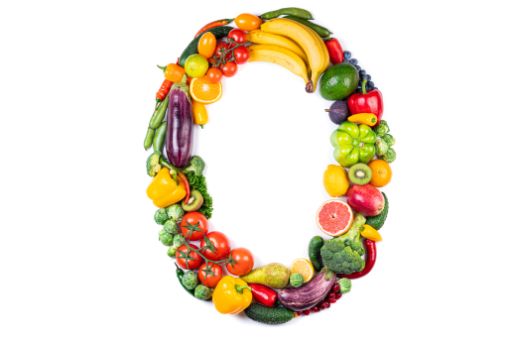
Some examples of 0 calorie foods include:
• Celery: One medium stalk (40 grams) has 6 calories and 0.6 grams of fiber. Celery is also a good source of vitamin K and potassium.
• Lettuce: One cup (36 grams) of shredded lettuce has 5 calories and 0.5 grams of fiber. Lettuce is also a good source of vitamin A and folate.
• Cucumber: One cup (104 grams) of sliced cucumber has 16 calories and 0.8 grams of fiber. Cucumber is also a good source of vitamin K and water.
• Zucchini: One cup (124 grams) of chopped zucchini has 20 calories and 1.4 grams of fiber. Zucchini is also a good source of vitamin C and manganese.
• Tomatoes: One medium tomato (123 grams) has 22 calories and 1.5 grams of fiber. Tomatoes are also a good source of vitamin C, lycopene, and other phytochemicals.
• Broccoli: One cup (91 grams) of chopped broccoli has 31 calories and 2.4 grams of fiber. Broccoli is also a good source of vitamin C, vitamin K, folate, and sulforaphane.
• Cauliflower: One cup (107 grams) of chopped cauliflower has 27 calories and 2.1 grams of fiber. Cauliflower is also a good source of vitamin C, vitamin K, folate, and glucosinolates.
• Mushrooms: One cup (96 grams) of sliced mushrooms has 21 calories and 0.7 grams of fiber. Mushrooms are also a good source of vitamin D, selenium, and ergothioneine.
• Grapefruit: One half of a medium grapefruit (123 grams) has 52 calories and 2 grams of fiber. Grapefruit is also a good source of vitamin C, vitamin A, and naringenin.
• Watermelon: One cup (152 grams) of diced watermelon has 46 calories and 0.6 grams of fiber. Watermelon is also a good source of water, vitamin C, lycopene, and citrulline.
To include more 0 calorie foods in your diet, you can:
• Eat them raw as snacks or salads
• Add them to smoothies, soups, stews, or stir-fries
• Roast them in the oven with some herbs and spices
• Grill them on skewers or in foil packets
• Pickle them in vinegar or brine
Gallstones Foods to Avoid
Gallstones are hard deposits that form in the gallbladder, a small organ that stores bile, a fluid that helps digest fats. Gallstones can cause pain, inflammation, infection, or blockage of the bile ducts, which can lead to serious complications. The exact cause of gallstones is not clear, but some factors that may increase the risk include obesity, diabetes, rapid weight loss, fasting, pregnancy, hormone therapy, genetics, and certain medications. Diet may also play a role in gallstone formation and prevention.
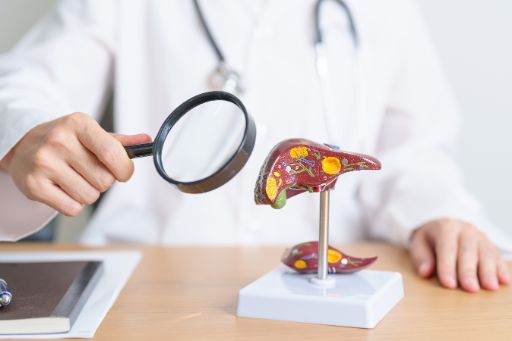
Some gallstones foods to avoid or increase the risk of developing them include:
• Fatty foods, such as fried foods, fast foods, processed meats, butter, cheese, cream, ice cream, pastries, cakes, cookies, chocolate, and nuts
• Refined carbohydrates, such as white bread, white rice, white pasta, sugar, candy, soda, and juice
• Alcohol of any kind
• Caffeine of any kind
• Spicy foods of any kind
To prevent or reduce gallstone symptoms, you can:
• Eat more fiber-rich foods, such as fruits, vegetables, whole grains, legumes, and seeds
• Eat more lean protein sources, such as fish, poultry, eggs, and low-fat dairy products
• Eat more healthy fats, such as olive oil, avocado, flaxseed, and fish oil
• Drink plenty of water and herbal teas
• Limit your intake of salt and sugar
• Avoid skipping meals or fasting for long periods
• Maintain a healthy weight and lose weight gradually if needed
• Exercise regularly and moderately
High Volume Low Calorie Foods
High volume low calorie foods are foods that have a high water and fiber content and a low calorie density. Calorie density is the amount of calories per gram or per volume of food. Foods with a low calorie density tend to fill you up faster and longer with fewer calories than foods with a high calorie density. This can help you control your appetite and calorie intake and support weight loss or maintenance. High volume low calorie foods are usually fruits and vegetables that are rich in vitamins, minerals, antioxidants, and phytochemicals that can benefit your health in various ways.
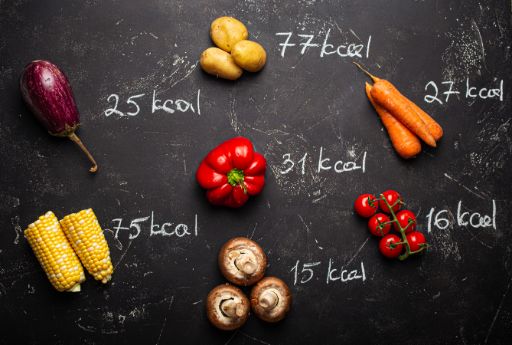
Some examples of high volume low calorie foods include:
• Leafy greens, such as spinach, kale, lettuce, arugula, and collard greens
• Cruciferous vegetables, such as broccoli, cauliflower, cabbage, brussels sprouts, and bok choy
• Other vegetables, such as carrots, celery, cucumber, zucchini, asparagus, artichokes, eggplant, and peppers
• Berries, such as strawberries, blueberries, raspberries, blackberries, and cranberries
• Other fruits, such as apples, oranges, grapefruits, kiwis, pears, plums, peaches, and melons
• Soups and broths made with water or low-sodium vegetable stock and vegetables
To include more high volume low calorie foods in your diet,you can:
• Eat them raw as snacks or salads
• Add them to smoothies, soups, stews, or stir-fries
• Roast them in the oven with some herbs and spices
• Grill them on skewers or in foil packets
• Make them into purees, mashes,or dips
Copper Rich Foods
Copper is an essential trace mineral that plays a role in many biological processes, such as energy production, iron metabolism, antioxidant defense, collagen synthesis, nerve function, and immune system regulation.
Copper deficiency can cause anemia, neutropenia, osteoporosis, skin problems, hair loss, and neurological disorders.
Copper toxicity can cause nausea, vomiting, diarrhea, headache, dizziness, liver damage, and kidney failure.
The recommended dietary allowance (RDA) for copper for adults is 900 micrograms (mcg) per day.
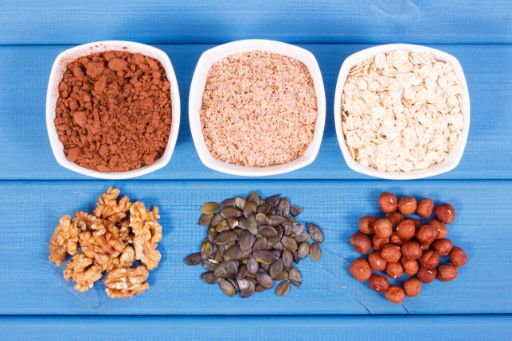
Some of copper rich foods :
• Organ meats, such as liver, kidney, and heart
• Shellfish, such as oysters, clams, mussels, crab, and lobster
• Nuts and seeds, such as cashews, almonds, pistachios, sunflower seeds, and sesame seeds
• Legumes, such as lentils, chickpeas, beans, and soybeans
• Whole grains, such as oats, barley, quinoa, buckwheat, and rye
• Dark chocolate and cocoa powder
• Dried fruits, such as raisins, prunes, apricots, and figs
• Mushrooms and seaweed
To include more copper-rich foods in your diet, you can:
• Eat organ meats and shellfish once or twice a week
• Snack on nuts and seeds or add them to salads, yogurts, or oatmeal
• Cook with legumes or use them to make soups, stews, curries, or hummus
• Choose whole grains over refined grains or use them to make breads, muffins, pancakes, or porridge
• Enjoy a small piece of dark chocolate or a cup of cocoa as a treat
• Add dried fruits to your cereals, smoothies, or trail mixes
• Add mushrooms and seaweed to your soups, salads, or stir-fries
Hemoglobin Rich Food
Hemoglobin is a protein in red blood cells that carries oxygen from the lungs to the tissues and carbon dioxide from the tissues to the lungs. Hemoglobin also helps maintain the shape and function of red blood cells. Hemoglobin levels depend on the number and size of red blood cells and the amount of iron in the body. Low hemoglobin levels can cause anemia, which is a condition characterized by fatigue, weakness, shortness of breath, pale skin, and increased susceptibility to infections. High hemoglobin levels can cause polycythemia, which is a condition characterized by increased blood viscosity, blood clots, headaches, dizziness, itching, and increased risk of stroke and heart attack.
The normal range of hemoglobin for adults is 13.5 to 17.5 grams per deciliter (g/dL) for men and 12 to 15.5 g/dL for women (5).
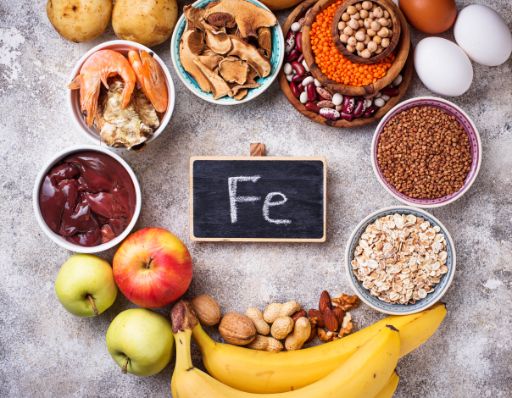
Some of the foods that can help increase hemoglobin levels include:
• Iron-rich foods, such as red meat, poultry, fish, organ meats, eggs, legumes, nuts, seeds, dried fruits, dark green leafy vegetables, and fortified cereals
• Vitamin C-rich foods, such as citrus fruits, berries, kiwis, peppers, tomatoes, broccoli, cauliflower, and cabbage. Vitamin C enhances the absorption of iron from plant sources.
• Folate-rich foods, such as spinach, kale, lettuce, asparagus, avocado, beets, lentils, beans, peas, and fortified cereals. Folate is needed for the production of red blood cells.
• Vitamin B12-rich foods, such as animal products, dairy products, eggs, fortified cereals, nutritional yeast, and supplements. Vitamin B12 is needed for the synthesis of hemoglobin and DNA.
• Copper rich foods, such as organ meats, shellfish, nuts, seeds, legumes, whole grains, dark chocolate, dried fruits, mushrooms, and seaweed. Copper is involved in the metabolism of iron and the formation of red blood cells.
Some of the foods that can help lower hemoglobin levels include:
• Fluids, such as water, herbal teas, juices, and soups. Fluids can help dilute the blood and prevent dehydration.
• Antioxidant-rich foods, such as fruits, vegetables, herbs, spices, tea, coffee, cocoa, and wine. Antioxidants can help protect the blood vessels from oxidative stress and inflammation.
• Anti-inflammatory foods, such as fish oil, olive oil, flaxseed oil, walnuts, chia seeds, turmeric, ginger, garlic, onion, and pineapple. Anti-inflammatory foods can help reduce the production of inflammatory cytokines that stimulate erythropoietin (EPO), a hormone that stimulates red blood cell production.
• Phlebotomy or blood donation. Phlebotomy or blood donation can help reduce the excess blood volume and hemoglobin levels.
To include more hemoglobin-rich foods in your diet,you can:
• Eat iron-rich foods with vitamin C-rich foods to enhance iron absorption
• Eat folate-rich foods with vitamin B12-rich foods to support red blood cell production
• Eat copper-rich foods with iron-rich foods to facilitate iron metabolism
• Eat a balanced and varied diet that includes all the essential nutrients
Conclusion
Eating a healthy and balanced diet can help you improve your health and well-being in various ways. It can also help you achieve specific goals, such as increasing hemoglobin or burning belly fat. However, no single food or food list can provide all the nutrients and benefits that your body needs. Therefore, it is important to eat a variety of foods from different food groups and subgroups every day. It is also important to eat the right amount of foods for your energy and nutrient needs and avoid overeating or undereating. Finally, it is important to eat foods that are suitable for your individual needs and goals and seek professional advice if needed.



